The Evolution of Mobile Ads
Nowadays ads pop up on every corner of our life; in a supermarket, on a newspaper, tv and our very own pocket computer also known as a mobile device.
I’ll be focusing purely on the mobile ecosystem; so here it goes.
Introduction
Mobile advertising got stronger with better mobile devices on the market; a better device means better hardware and software, which leads to more sophisticated ads; from static images to interactive ads to video and finally playables. Yes, playables; ads where you actually play a mini/demo game embedded into an ad view, which triggers your interest in the advertised game and you actually install it.
With bigger variety of ad formats advertisers have more power to persuade the user to click their ad and hopefully make a conversion; whether it’s installing an app, buying baby diapers or reserving a flight to Dubai, whatever the ad creative advertises.
Today it’s a lot easier to create quality ads as there aren’t many restraints in terms of mobile device hardware and data transfer limits.
I’ll talk about the ~10 year difference in advertising space in terms of advertiser spending, ad formats, mobile devices and some other advertising related topics.
Buckle up, there’s gonna be a few charts.
Around 2010
How to monetise a mobile application? Besides the premium mobile apps, the ones that can be installed only after payment, another way app developers could monetise their games is through in-app advertising.
Ads were present from the very beginning of smartphone existence.
Quite a lot of new advertising companies popped up when people saw the trajectory mobile development is heading.



In short; advertising companies, also known as advertisers, get the advertising material from companies that want to advertise their products, such as CocaCola, Adidas,…, and these advertisers then find the best sources to advertise these products. One of these sources being mobile phones, or more specifically applications installed on them.
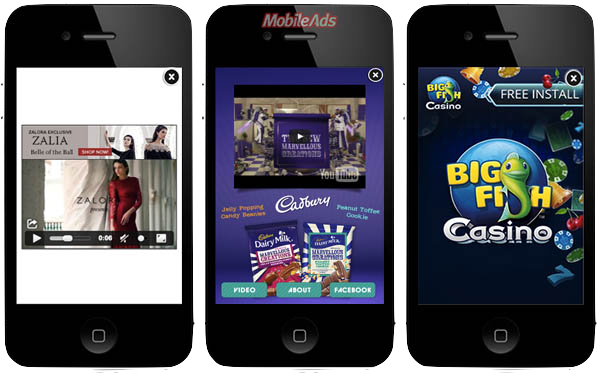
Ad Formats
Since there were constraints of mobile data transfer limits and internet speed, the ads weren’t as beautiful as they are nowadays (although it doesn’t make them any less annoying). Advertising agencies had to adapt to the device limits at that time, thus only certain ad types were meaningful; the ones that were the most optimised in terms of size and complexity/performance. The most popular ad type at that time were banners, since they had small sizes and were lightweight.
Other types, such as videos, were quite tricky for advertisers as there was such a huge spectre of different screen sizes and resolutions out in the open. Video format gained popularity in the later years when mobile devices became better and mobile data transfer became cheaper and more attainable to the broader public.
Along with everything else that was different from today, banners also looked quite poorly compared to the ones used nowadays. Here’s an example of Google’s in-app advertising:
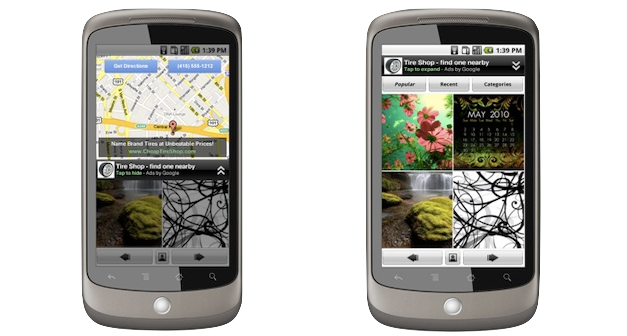
As companies noticed the rise of smartphone popularity, quite a few mobile advertising agencies and ad networks were born in 2010. Each company wanted to get the leading edge in the sea of competition in advertising space, thus each introduced new or improved concepts. A good example is InMobi’s introduction to tablet banners: “Introducing Banners For Tablets Including iPads”, since tablets such as Apple’s iPad and Samsung’s Galaxy Tab started to gain traction.
Rich media ads started to pop up, though in 2010 they were still treated as experimental. What are rich media ads, you ask? Well, they are essentially ads that give the user a more rich experience; they offer more in-app interactivity via video, sound, gaming and so on.
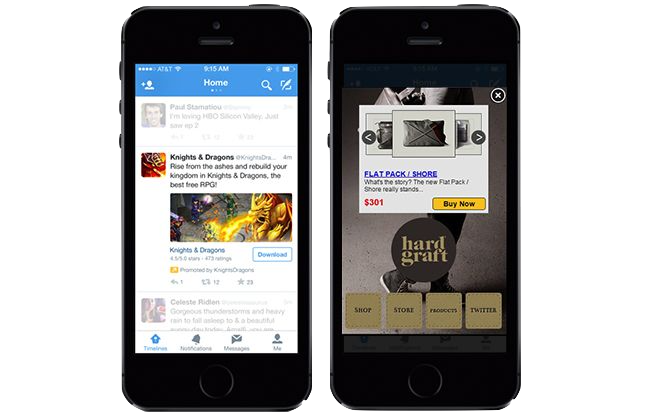
In terms of popularity there were
- banners — taking the first place as they weren’t complex and were the most appropriate for conditions ad that time
- interstitials — fullscreen (mostly) static ads, at that time interstitials were more like “bigger banners”
- videos — due to slow device internet connection and data limits they weren’t as much favorable to advertisers
- native — ads that would blend into app content, such as Facebook’s Sponsored tag More about ad formats can be read here.
To get a perspective, here’s the data for most effective ad formats from 2015:

Mobile vs Web
Advertisers were quite confused whether they should spend their money on web apps, mobile apps or both, since web mobile apps started to gain popularity. Along with advertisers, the developing companies were also a bit confused since they didn’t know whether they should focus on mobile web apps or mobile native apps.
The popularity was driven by the shorter and cheaper development cycle, since companies wouldn’t need native Android and iOS developers, instead they would just have one proficient web developer with basic knowledge of native Android and iOS to make a functional mobile web app.
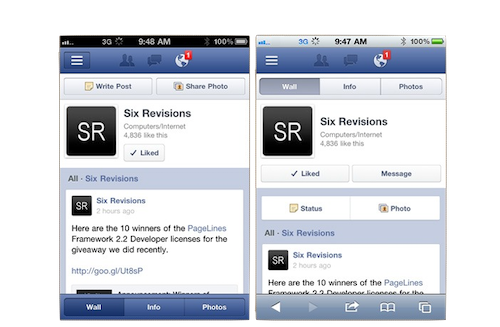
Ad SDKs
An Ad SDK (Software Development Kit) is essentially a package of code that a developer includes in its own game which enables the app to start serving ads from the SDK Ad Provider (AdMob, Applovin, Smaato, Chartboost,…) without any special technical config. SDKs were and still are the most popular in the Mobile advertising sphere having a really big share in mobile advertising compared to S2S (server-to-server) implementation. Though, some S2S ad providers would preach S2S implementation is better than SDKs, from the publisher’s perspective the SDK implementation is easier as the Ad Provider is responsible for all technical updates to Ad serving and displaying.
You know things started to get serious when Google makes their move. In 2010 Google published an article titled “We’ve officially acquired AdMob!”. If, by any chance, you didn’t know this: AdMob is currently (2021) one of the largest, if not the largest, mobile ad networks in the mobile advertising space.
Report from TechCrunch’s article in 2011: “In the group containing just the top 1,000 ad-supported (Android) apps, 89% used AdMob’s SDK, 34% used Millennial Media’s SDK, 22% used Inmobi, 19% used AdWhirl and 15% used Mobclix.”.
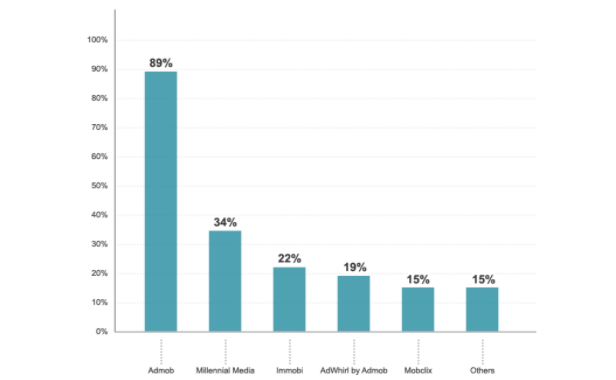
Report from a different TechCrunch’s article in 2011: “Chartboost, the newly launched (already profitable) direct deals marketplace for mobile game developers is today announcing its expansion to Android. The company provides free ad-serving technology for direct deals and cross-promotions via its Chartboost SDK, allowing publishers to retain 100% of the revenue share on their direct deals.”. Just for reference, Chartboost is one of the most popular Mobile Ad SDKs in 2020.
Ad Spending
Mobile ad spending reached its highs each year:
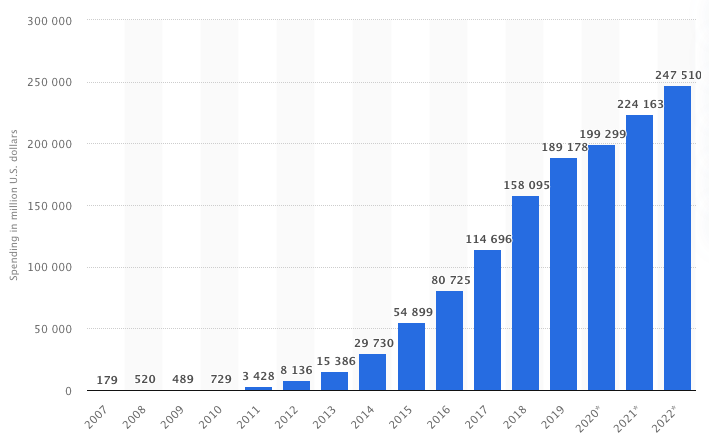
Devices
A few introductory explanation:
- CPM (cost per mile) — an amount of money the advertiser is willing to pay for 1000 impressions. Impression means that the ad was actually displayed to the user (for example a full screen interstitial pops up).
- CTR (click through rate) — number of clicks per shown ad
- Fill rate — when an app makes a http request to the ad provider’s side requesting for an ad, this ad provider might or might not have an ad ready for the current user/device/app.
Apple products were treated as premium devices, causing quite higher CPMs compared to more accessible Android devices, which were significantly cheaper in terms of device price tag.
So why a higher CPM for Apple devices? Well, since Apple devices were the most expensive, its owners usually had above the average net worth, thus they would be more desirable to advertisers as they tend to spend more than the users with cheaper devices, meaning the ad would be much more effective for these Apple’s users.
Apple devices do have higher CPMs since they also have higher CTRs, but Android devices have a bit higher Fill Rate as seen below:



Ads around 2020
Ten years is quite a long period in technological advancement. Mobile devices were subjects of significant hardware and software development and some new mobile manufacturing companies got popular such as OnePlus, Xiaomi, … compared to 10 years ago, when these names were not that significant or didn’t even exist.
Mobile advertising has again seen new highs in terms of ad spending and mobile platforms became one of the most desirable for advertisers.
Ad Formats
Since mobile devices got really powerful in terms of hardware and software and data transfer limits are almost limitless, mobile advertising is no longer a problem and ad creators are no longer bound to strict size limits and performance, thus more sophisticated ad formats became popular:
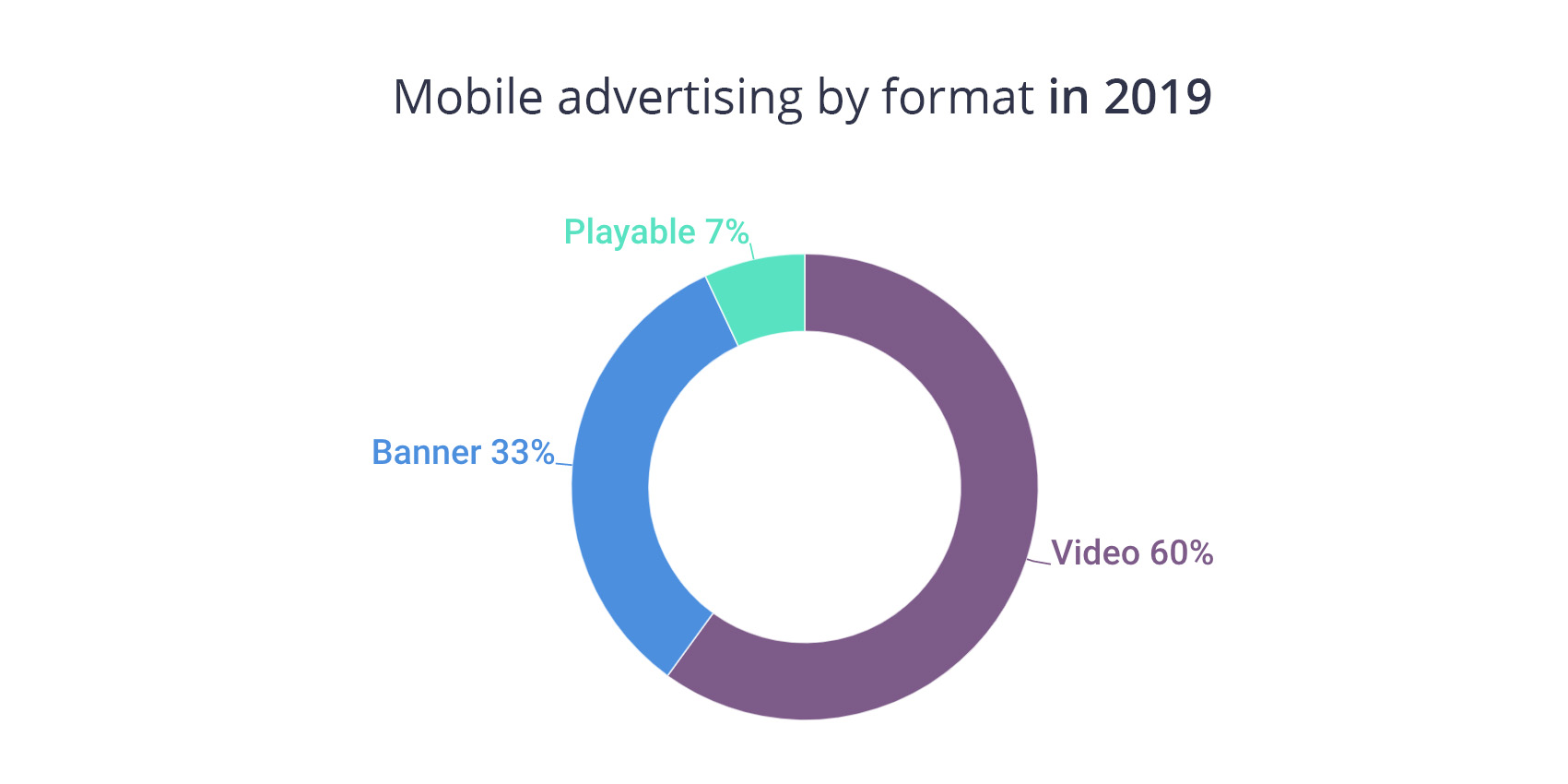
Ad SDKs
As we can imagine, Google is still dominating the Mobile SDK Ad space. Apart from Google, others are not that much different from one another in terms of popularity:
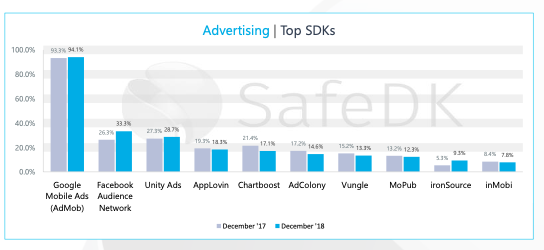
Ad Spending
Mobile Ad spending reached new highs yet again and projections show consequential year over year increases per PubMatic’s report:
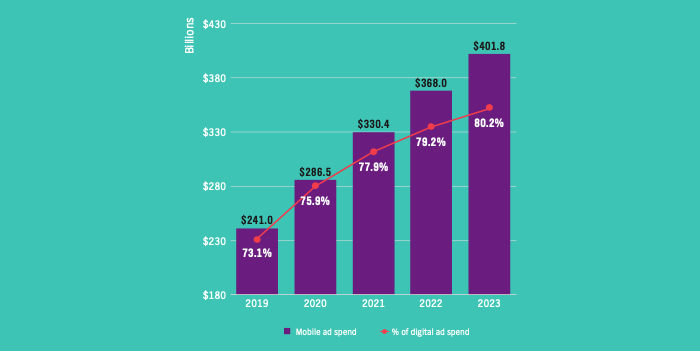
In the beginning of 2018 a new advertising solution started to liftoff; header bidding. Although it has been present on desktop web for quite a while now, publishers and advertisers showed interest in it on mobile. According to PubMatic header bidding in America has seen uplifts of more than 300% in 2018:
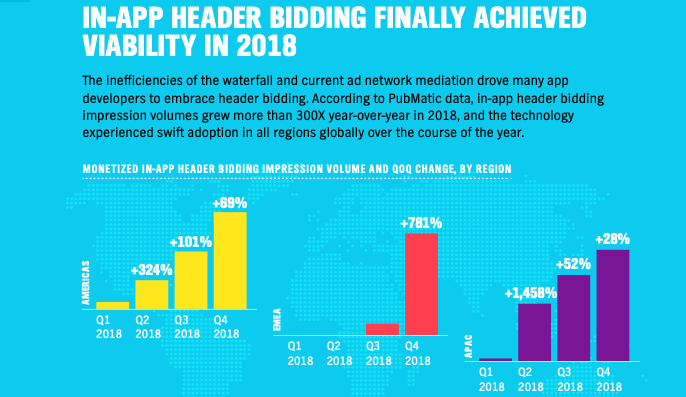
Devices
From 2018 to 2021 the quality of mobile devices started to increase and Apple finally got a bit of competition. Up until this point Apple was considered as a premium mobile device provider, but companies like Samsung, OnePlus, … started producing their own high-end smartphones thus getting closer to Apple in terms of device quality, performance and even price range.
Venturebeat article made a bold statement that Android in-app revenue might surpass iOS, but even if it didn’t, Android sure as hell came very close.
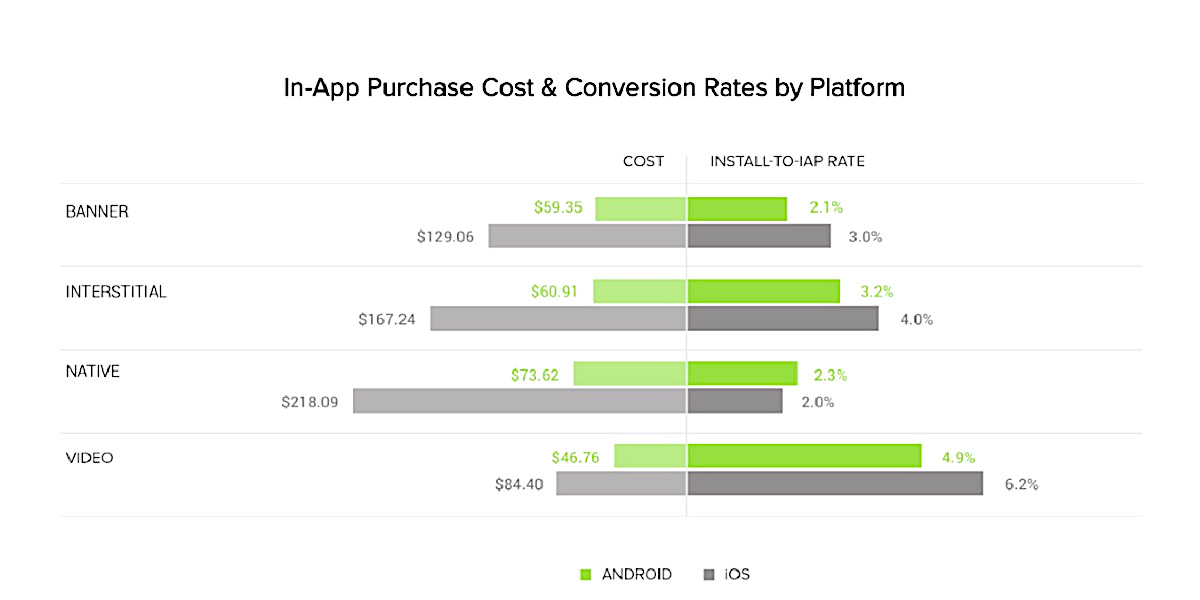
Conclusion
Mobile advertising spending is increasing year over year and since Mobile app stores (Apple’s AppStore and Google’s GooglePlay) strive towards higher in-app purchase cuts, ads won’t be obsolete anytime soon.
Mobile devices are getting better and data transfer is getting cheaper and almost limitless, which enables mobile ad creative developers to create ad creatives of higher quality which make them more desirable towards the end user.
It will surely be quite interesting to see what the future of mobile advertising brings.





